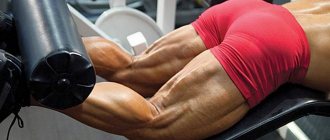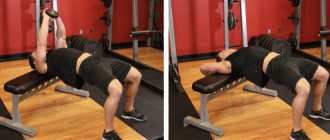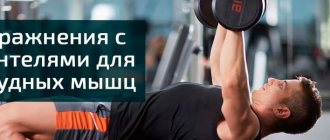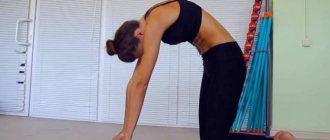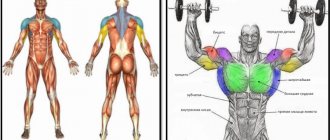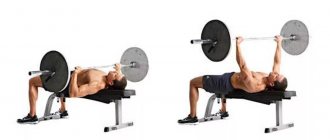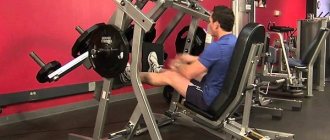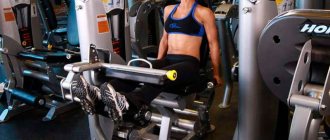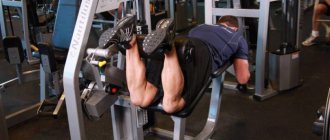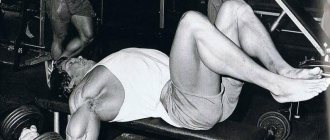In fact, there are two presses in the Hammer simulator. One lever machine with this name is aimed at working the chest muscles, the other - at the shoulders. And there is no mistake in this, it’s just that lever exercise machines are quite popular in professional clubs and are used often. The chest hammer is an option for a separate multi-joint exercise for a beginner or to “finish” the pectoral muscles for someone who can already perform bench presses with free weights. Unlike the pulley machine, the Hammer allows you to press with one arm to create a completely symmetrical load on the muscles.
Execution technique
Initial position
- A beginner can start the exercise with the weight of the machine itself, without weights. The person who continues already knows how much weight he needs for warming up and adds additional weights. First we assemble the simulator;
- Then the height of the bench is adjusted. Typically, this type of exercise machine has an adjustable seat, and you need to make sure that in the initial position the thigh is parallel to the floor;
- You should sit in the simulator, bring your shoulder blades together and lower them towards your pelvis. But you shouldn’t “forcibly” press your lower back against the back of the exercise machine. The position of the shoulder blades should be natural for all pressing movements that exist.
Movement
- An athlete performs a chest press. By contracting the pectoral muscles, he pushes the handles of the machine forward with his hands;
- Then follows the reverse movement - bending the elbow joints and lowering the weight onto the chest;
- After this, the required number of repetitions is performed and the athlete completes the exercise;
- The working weight may increase from approach to approach if this is provided for in the plan.
It's a HUMMER PRESS, baby!
Attention
- This is not a competition press where you have to stick your elbows in to get a pass. The pectoral muscles work great even if you don’t perform a lockout;
- The Hammer Press involves gathering the shoulder blades and fixing them against the spine. You should not take a starting position in which your back and lower back are tightly pressed against the back of the exercise machine. Not all people can achieve a forward pressing movement with a relaxed back and slightly rounded shoulders forward. On the contrary, they will experience pain if they begin to bench with this particular technique;
- The Hummer press does not allow for significant grip width adjustment. The only way to adjust is to adjust the height of the machine. The grip width will be determined by the length of the handles. For those who have narrow shoulders and back, it is recommended to take it as narrow as possible and as comfortable for the shoulders as possible;
- There is no need to lift your back from the backrest, nor do you need to move your shoulders forward or nod your head. These “auxiliary movements” interfere with the technical execution of the exercise and prevent activating the chest muscles;
- The arms should roughly project to the middle of the chest. If they are higher, then injury to the tendons of the shoulder is possible, because the position of the shoulder joint becomes anatomically incorrect;
- Avoid arching your wrists; if they are arched, the entire weight of the machine will be on them, not just the chest muscles. This is a very unfavorable position due to the fact that it contributes to injury;
- Gradually approach the working weights. Do not use maximum weights, especially if you have been working in the simulator recently and have also recently entered the gym. Avoid a machine that is too overloaded and requires you to press the weights with your hands one at a time. Work in the Hummer, although considered by many bodybuilders to be a strength training, is not actually a “platform for setting records.” Be adequate in choosing working scales.
Leg press in a block machine
This equipment is intended to improve the quality of working out the muscle group of the thighs. The machine engages the lower part of the body.
The position of the legs can change at each workout, depending on the area being worked.
You need to work in the simulator with the correct technique:
- The working weight is set.
- We arrange the required position of the legs, the platform is freed from the stops.
- The knees are lowered to 90 degrees.
Recommendations
- The safest angle for the shoulder joint is when the forearm goes to the body at an angle of 45 degrees. Some machines are designed to allow you to press safely with your elbows out, but not all machines do. Ideally, you need to find a reasonable compromise between stretching the chest and a pain-free position for the shoulders. In the end, an athlete can do a dumbbell or butterfly fly at the end and not worry about stretching;
- Be sure to approach the working weight through a warm-up. The ligaments in the chest are usually easily injured if the maximum weight is applied immediately after the warm-up. Let's allow a step of 5 kg for beginners and 10 or more for intermediate ones;
- The exercise should not lead to pain in the elbows and wrists due to an anatomically unnatural body position. If the position is not natural, you should collect your shoulder blades and find a position in which there will be no pain;
Contraindications
Hammer is unique in that it has virtually no limitations. It will be an ideal alternative for all those who have problems with shoulder joints. The exercise machine is also suitable for people with back pain. The device avoids stress on the spine and is an ideal replacement for basic exercises.
Don't neglect proper technique. When doing presses, do not lower the handle below chest level to avoid damaging the ligaments. Your wrists should remain straight while performing the exercises. And, most importantly, lumbar “bridge” should be avoided. Such deflections have nothing in common with the correct technique.
People with pathologies should consult a doctor before visiting the gym. Everyone else can safely start training in the Hummer. Thanks to the design of the simulator, the muscles will develop symmetrically, so the installation is suitable for both beginners and experienced athletes. With regular practice, progress will not take long.
It is not recommended to use the exercise machine for ruptures and sprains of the pectoral muscle, ligaments, joint injuries and all kinds of inflammatory processes.
Execution options
- Vertical press . This is an exercise for deltoids; it is usually not classified as a variation of the hammer press, if only because it focuses on working another group of muscles, and it would not be logical to compare the chest press and the shoulder press. The vertical press works more on the front and middle deltoids rather than the rear ones;
- Angle press . In some lever exercise machines, you can tilt the backrest so that you can press exclusively using the chest muscles, and not use the deltoids. This bench press variation is loved by bodybuilders as it more isolates the chest muscles;
- Grip width . It is believed that the wider the arms in the exercise, the better the chest is worked, and the narrower the exercise, the larger the triceps. Although some machines allow, with a narrow setting, to shift the emphasis to the muscle bundles closer to the center of the chest;
- One-arm press . The lever design allows you to perform this option, which is not very common in fitness, but widely used in bodybuilding. This press allows you to achieve a completely symmetrical physique, which is important for the aesthetics of the body.
HAMMER PRESS for the chest! Kock technique!) VOD
Weekly volume
Each week you should do a certain number of repetitions.
Consequently, problems may arise associated with overtraining, which interferes with achieving results.
Finding the sweet spot can be difficult because the heavier the weights, the fewer reps you can do. This theory is especially relevant for the deadlift - the most effective and difficult exercise for the back muscles.
When lifting heavy weights (80-85% of your one-rep max), you should do 60-70 reps per week. This number of repetitions is the most optimal.
We recommend reading: Chest training program
This technique is applicable not only to the back muscles, but also to any other muscle groups.
Analysis of the exercise
What muscles work
Biomechanically, this is a normal pressing movement. These include the muscles of the front surface of the body, as well as the latissimus and rhomboids as stabilizers. Due to the nature of the exercise, engaging the back is only possible statically, since in the simulator we eliminate the pushing of the projectile from the chest.
The moving muscles are activated according to the following principle:
- The pectoralis major as the main one;
- Triceps and anterior deltoids as auxiliary muscles
The legs in this exercise simply rest on the floor, so you should not consider the work of the quadriceps and hamstrings to be anything other than stabilizing the core.
Preparation for execution
- Warming up before a bench press should under no circumstances include stretching or anything like that. First, the pectoral muscles, anterior deltoids and triceps are rolled on the roller, then you need to do a general warm-up in the elliptical trainer and after that a set or two of stretching the rubber in front of the chest. After that – 1 set of the “scarecrow” exercise, and that’s it, you’re ready for the first approach with minimal weight;
- The first set should be performed with an empty machine, and then add weight. It is this type of work that will allow you to avoid injuries and approach the working weight correctly.
Proper execution
- Fingers should comfortably clasp the handles of the simulator, but not be fixed on them;
- If the hands are still weak and it hurts to press, hand bandages are recommended;
- It is not recommended to sit on the edge of a bench and rest only your shoulder blades on the bench and your feet on the floor;
- It is not recommended to hang pancakes like the last time. This is not an exercise for setting strength records. The weight should be such that the athlete can press it 10-12 times without much discomfort, but with a feeling of muscle fatigue at the end;
- The pace of work in the simulators is recommended to be smooth, without distortions, jerks, springs, or bounces;
- Experienced lifters who practice hammer drop sets should still work at a moderate tempo rather than pushing the weight through by twisting their elbows.
Errors
- Movements of the back while working, pushing the weight by fidgeting on the bench;
- Raising the shoulders to the ears;
- Separation of the shoulder blades from the back of the exercise machine;
- Constantly changing angle at the wrist;
- Wrist flexion and weight pushing due to reduced amplitude;
- Lifting of the feet, lifting them off the floor and unstable body position due to this
Efficiency Tips
- You need to learn to feel the work of the pectoral muscles, to do this, concentrate strictly on them, and not on movement and not on your arms;
- “One-armed” presses are included in the plan as soon as asymmetry in muscle work is noted. It is easy to notice, because then the athlete pushes the projectile with a clear distortion, and it is present in all exercises of the bench press plan. This may be caused by a natural difference in strength, or by the fact that a person has scoliosis and the back muscles work unevenly;
- The more smoothly and efficiently the warm-up is done, the more effective the press will be. A typical mistake is to rush to do an exercise in a machine because it is “easier than the basics” without warming up. This should not be done under any circumstances;
- If in women's training, especially in the case of ladies with implants, this may be the only exercise, then in men's training it is recommended at least one more for the chest, and several presses for the shoulders and triceps
Mistakes during training
Often, beginners, having seen enough of great athletes with many years of experience, begin to perform an exercise called a hammer press.
There is a desire to imitate and after the simulator is free, they begin to actively perform the exercise. After observing this in the room, I saw the most common mistakes. 1. Shoulders are brought forward. Our main goal is to pump up the lower chest. When moving the shoulders forward, the load from the chest is reduced and moves to the deltas. To avoid this mistake, it is recommended to press your back tightly against the backrest. 2. Elbows should be at your sides. If the elbows are pressed tightly to the body, then the load from the pectoral muscles goes into training the triceps. 3. Too much weight. The hammer press is an isolation exercise in which weight is not the key objective. Our task is to work a specific muscle group, in our case the chest. Remember, quality beats quantity. 4. Correct breathing. If you breathe incorrectly, it becomes more difficult to perform the exercise. Doing a variety of presses helps you hone your physique in the best way possible. Thus, if you have a question about how to replace such an exercise, I recommend the overhead press.
In conclusion, I would like to say that the exercise is intended for experienced athletes who should not bother with the correct technique. For beginners, the hummer press will not help you build large muscle mass; for this you need to build a base.
Well, that's all, we talked about an interesting exercise that will sharpen your chest. If you pay close attention to the correct technique and avoid mistakes, you can achieve excellent results. I also attach an interesting video to help. Outstanding sporting results.
Alexander Bely
When to expect an effect
Hammer training blocks consist of various exercises. To evaluate the results of your work, you need to conduct at least 4 full workouts. If we take into account that the training block is designed for one full week, then it will take 4 weeks to evaluate the first result, provided that the planned program is regularly followed.
The hummer simulator is designed for isolating work on pumping the pectoral muscle group. Doing exercises on a humvee is part of a complex sports program. The exercise machine helps tighten the pectoral muscles, minimizes the risk of injury, and allows you to focus on working on a specific muscle group.
Advantages and disadvantages
Experts in heavy training note that the hummer, in fact, has only one significant drawback: this simulator cannot be adjusted to the individual characteristics of the athlete’s figure.
But the main advantage of the hummer is that the mechanism used to develop the simulator helps reduce the likelihood of injuries.
This can be clearly seen when comparing two types of exercises, for example, the barbell bench press and the hummer bench press:
- the hummer allows you not to overstrain the joint, forcing it to also hold the load in an upright position;
- the simulator prevents the load from swinging, which frees up the stabilizer muscles;
- the hammer helps distribute the load evenly on both sides, but free weights can “walk.”
Some bodybuilders even complain that they oversize one side to the detriment of the other. They can only advise one thing - a hummer, in which it is impossible to deviate from an already verified trajectory.
Some people think that the machine does not help build muscle mass, but this is not a drawback. Athletes traditionally build muscle with barbells or dumbbells. But when the stage of grinding the reliefs comes, the hummer is irreplaceable.
Based on the above, it becomes clear: the hummer will be the best assistant for people who are not involved in professional bodybuilding. If you just need to develop your chest, maintain beautiful muscle volume, and develop the strength of your pectoral muscles, then don’t pass by the hummer.
It is quite important to remember the safety guarantees that the hummer provides: when bench pressing, the load will not fall on your chest or face - the hummer is equipped with a special bar that secures the load. The hummer is designed in such a way that weights from a barbell are used as a load, and in other devices, for example, roller ones, a system of weights built into the mechanism
In these machines, the weight is lifted through a winch. Movement through a winch places an uneven load at different points, and lever mechanisms compensate for this disadvantage
The hummer is designed in such a way that plates from a barbell are used as a load, and in other devices, for example, roller ones, a system of weights built into the mechanism is used. In these machines, the weight is lifted through a winch. Movement through a winch places uneven loads at different points, and lever mechanisms compensate for this disadvantage.
Engagement of joints and muscles
As noted above, the hammer press has one interesting advantage - the ability to focus the load on the shoulders, chest and legs. During the execution, many muscles are involved, for example, when training the pectoral muscles, the triceps and anterior delta will work, but their role, compared to the pectoral muscles, is minimal.
The lion's share also falls on the chest muscle bundles. That is, if previously the chest developed unevenly, then the upper hammer press while sitting or lying down will help get rid of these imbalances. To get a decent result, you only need to shift the load to the arm where the bundle is lagging behind in development.
During the exercise, you should carefully monitor your back - it should be clearly fixed and pressed tightly against the back of the machine to avoid injury. In addition, when performing, you do not need to try to strain the maximum number of muscles, since the main goal is precisely a high-quality bench press in a hammer, but in no case an increase in weight.
Joints, unlike major muscle groups, do not experience enormous stress during training on a hummer machine. They move according to a clearly established amplitude. This is where another advantage of this type of exercise lies - the minimal risk of harm to the joints of the arms (elbow and shoulder) and legs.
In general, we can talk about the absence of risk only if the athlete complies with all the rules for performing the bench press. Excess weight can become a big problem, as it will create additional stress on the joints, and the pre-fixed amplitude in this situation will only play a negative role. During the exercise, the athlete will not be able to change the position of his hands in any way, since this can only be done with a barbell or dumbbells. Unnatural placement of the hands and elbows, as well as excessive load, are guaranteed to lead to injury. Following this, it is necessary to perform the bench press in compliance with all the rules, without trying to complicate the exercises yourself to obtain a better effect.
Indications for use
The Hammer trainer is in demand by professional athletes as an auxiliary strength equipment that helps pump up the pectoral muscle group.
For non-professional athletes, the apparatus is recommended in several cases:
- To improve posture. Well-developed chest muscles are the key to proper placement of the shoulder blades.
- Improving the activity of the respiratory muscles . Pumping the pectoral muscle group helps increase the amplitude of inhalation and exhalation. This technique is recommended for those who have problems with the respiratory system, as well as for those who have been diagnosed with diseases associated with impaired lung function.
- Strengthening the upper shoulder girdle and back. Exercises may be recommended by your doctor as rehabilitation after specific injuries.
Consolidate the result
Performing a pressing movement is part of a program to pump up the pectoral muscle. To consolidate the results, you need to use all types of exercises aimed at improving the upper torso.
Types of exercises other than the chest press:
- Pullover. This is an effective exercise designed to work the back, which simultaneously pumps the pectoral and serratus anterior muscles. The pullover is performed after the bench press and arm raise.
- Push ups. These are basic exercises that complement traditional machine pressing movements. Dips or gravitron push-ups are suitable for beginners and are an excellent consolidation of the results achieved on the hammer. A home version of push-ups is floor push-ups.
- Bringing and spreading hands. Isolation exercises that focus on working the pectoral muscle group. Most often, these exercises complete training programs. They are recommended to be done on crossover simulators. An alternative would be to work with dumbbells from a lying position.
One option to help consolidate the results of weekly hammer training is to perform myofascial release. These are a type of special massage that is aimed at overcoming stiffness in a certain area of the body during training.
Myofascial type massage involves the use of massage balls or small balls. With their help, muscles are warmed up, clogging is eliminated, which interferes with obtaining results.
Massage balls are used to periodically knead the surface of the pectoral muscles or act on the trigger point. A trigger point refers to a site of spasm or block that responds with pain when pressed.
Specifications and description
The Hammer exercise machine is a sports equipment that allows you not only to achieve high results and performance, but is also a very convenient assistant in the fight for a beautiful body, which is suitable for all categories of people.
Among all the descriptions of the projectile, you should pay attention to the following details, which distinguish this simulator from the rest. This:
- Convenient and comfortable high adjustable seat, thanks to which every person, regardless of height and build, can exercise on this apparatus.
- The supporting backrest is designed so that you can take any comfortable position for training.
- Each handle passes in accordance with a strictly specified and specified trajectory, this has its own advantage, which is that the handles are mechanisms that are independent of each other.
- The total weight of the simulator is about 265 kg.
- The rear part of the machine is equipped with a system consisting of two weight blocks, the action of which is based on the principle of converging levers.
As a result of regular training on this sports equipment, all groups of chest muscles are worked out, while the peculiarity of the simulator is that all exercises can be performed on the lower, middle or upper section of the equipment.
Scheme for pumping muscles in a Hummer
What to replace
The exercise is so undemanding on equipment that it is usually not necessary to replace it. Almost everyone can find a pair of discs in their gym and perform the Svend press with them. But if a replacement is needed, it resembles the movement of mixing with a pause in the crossover, to the cables of which rubber shock absorbers are attached. It is this variation, especially with a pause in the middle of the amplitude, on the chest, that leads to the most complete “squeezing” of the chest muscles.
You can also replace the exercise by isometrically bringing your palms together in front of your chest. But this replacement relates, rather, to women's training, and not to bodybuilding.
Supersets with the Svend press should be structured in such a way that the chest stretching exercise comes first, and then the press. For example, it makes sense to perform the crossover in front of the chest first, and then the Svend. The same is true for dumbbells.
Beginners can try doing a superset of this movement to strengthen the muscles without overloading the stabilizers and causing poor technique. A well-known superset is also the wide-arm push-up and the Svend press.
The exercise can be performed with a medicine ball or shock absorber, then part of the emphasis will shift to the triceps. There are not many contraindications to the Svend press. Although this is not a strength exercise, it is not recommended for rehabilitation purposes for people with chest injuries, rotator cuff tears, or other shoulder injuries. In this case, you need to wait for complete recovery, and only then include the static load in the plan.
